Wednesday, December 28, 2005
Sunday, December 25, 2005
Christmas Eve, Silent Night? Nope------BOOM!
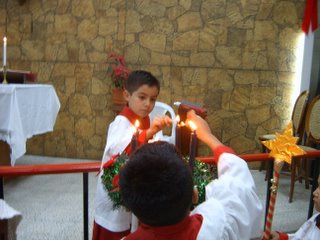 Lighting the Advent Wreath before the Christmas Eve misa, good practice for the firecrackers later that night.
Lighting the Advent Wreath before the Christmas Eve misa, good practice for the firecrackers later that night.Christmas Eve was awesome and loud, very very loud. Fireworks are big here on Christmas and yes, I hit up the stands, which were numerous in the city and loaded up on my share of dangerous minor explosives to celebrate and welcome in Christmas Day.
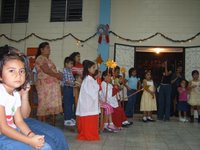 It was a joyous celebration, I'd have to say much more joyous and happy than Christmas in the states tends to be and not so caught up in commercialism, thankfully. Christmas Eve was about being with friends and family to Celebrate the birth of Christ, loudly. Amy pretty much had to yell out the Eucharistic prayer, "El Señor...Boom!...sea...Boom!....con....Boom!.....uste--des!!!!.....Boom!Boom!Boom!"
It was a joyous celebration, I'd have to say much more joyous and happy than Christmas in the states tends to be and not so caught up in commercialism, thankfully. Christmas Eve was about being with friends and family to Celebrate the birth of Christ, loudly. Amy pretty much had to yell out the Eucharistic prayer, "El Señor...Boom!...sea...Boom!....con....Boom!.....uste--des!!!!.....Boom!Boom!Boom!" We're not talking little lightweight wimpy American fireworks here. I saw kids lighting off firecrackers about the size of sticks of dynamite.
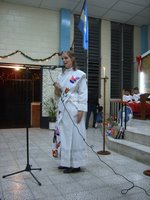 After the service we were invited to the Senior Warden's house for Salvadoran tamales, different than the Mexican tamales I grew up with, dodging fireworks along the way, and after returning home, sat around sipping Flor de Caña Rum( made from sugar cane flowers). We then opened a few presents, then at midnight, with the rest of the city it seemed, lit off fireworks. I've never seen anything like it, the noise was incredible. I did miss my family vey much (Most of Amy's family was here for
After the service we were invited to the Senior Warden's house for Salvadoran tamales, different than the Mexican tamales I grew up with, dodging fireworks along the way, and after returning home, sat around sipping Flor de Caña Rum( made from sugar cane flowers). We then opened a few presents, then at midnight, with the rest of the city it seemed, lit off fireworks. I've never seen anything like it, the noise was incredible. I did miss my family vey much (Most of Amy's family was here for the ordination) but had a great time and look forward to next years celebration.
the ordination) but had a great time and look forward to next years celebration.Vince Right: kids from church light off some tamer fireworks for a change of pace.
 Above: Audrey attempts to send off a Silbadore
Above: Audrey attempts to send off a SilbadoreMonday, December 19, 2005
The Neighborhood
We thought we'd take some time and describe the neighborhood around the church a bit more. It is a mix of poor working class and extremely poor people with a high level of gang violence in amongst, and surrounding, the neighborhood. Soyapango, the city in which the colonia Amatepec sits has the second highest rate of gang activity in the country. Lourdes, a city just outside of San Salvador, has the highest, though lately, it seems San Martin may unfortunately be steadily moving toward that designation. There, if the kids from the church enter the plaza in town, they will be killed by the gang that claims that territory because the kids are from a rival gang's territory. It doesn't matter that the kids do not belong to the gang who claims the territory where the church sits, just being from that area is enough.
In Amatepec, the area where the church sits is considered neutral for the time being. There is one gang territory above the church-Mara Salvatrucha and one below the church Calle 18. The narrow strip in between is nuetral and is where the church sits. Within the past few months near the church and surrounding streets, 10 people have been killed due to gang violence, 6 in a span of three days, which gave rise to a protest march against violence which Amy participated in with the Catholic and Lutheran clergy in the area--three of the people murdered were members of the nearby Catholic church. Some were family members of gang members killed in retaliation, others where drug addicts who crossed the gangs, some were gang members, and some were cobradors(money changers on the buses) and bus drivers--shot either during robbery attempts or for refusing to pay "renta", ransom, for going through gang territory. The buses in Amatepec are notorious for getting robbed by the gangs. Not surprisingly, the rise of the "mara" or gang problem here, which is enormous, has U.S. roots. Over the past years the U.S. government has had a policy of deporting Salvadoran gang members who grew up in the U.S., and have been arrested, back to El Salvador. Many are the children of refugees who fled with their families to the U.S. during the war, though they were never officially given refugee status by the Reagan administration because in the eyes of the Reagan administration they were not fleeing a tyrannical or dictatorial government at odds with the U.S. I guess U.S. trained death squads attacking your village were not considered a great enough threat to one's well being. The two main gangs Mara Salvatrucha and Calle 18 were formed in the U.S. in L.A. where they learned their vicious tactics and were imported with the aid of the U.S. government back into El Salvador. The reaction against them has been violent and has had an adverse effect on the youth, especially in a colonia like Amatepec where all young people are viewed by the police as possible gang members and treated as such. The youth in our church would actually like us to make cards for them that show that they are members of the church so they can easily let the police know that they are not gang members. They are routinely frisked and asked to remove their shirts, where the police look for tatoos, a sign of membership in a gang. All members of our youth group have been approached by the gangs and have said that it has been communication with their parents and involvement in the church that has kept them out. Though in some areas, the gangs have now taken to shooting kids who refuse to join.
Yet it is not all darkness in the neighborhood. It is a very vibrant place with vibrant hard working people. People who have been through alot and have an incredible resiliency about them. The neighborhood is made up of mostly refugees and ex-guerillas from the war. Due to this it seems, the government tends to neglect the area, except after the spats of violence (now on the corners are military soldiers with M-16 rifles, and the police have been checking the buses for gang members) and basic things such as reliable water service and utility service are spotty. The neighborhood is not that far from rural El Salvador, so we see cows wander in from time to time and eat at the piles of garbage that tend to accumulate along the street and from the church you can see the hillsides lined with rows of corn. It is a close community where even the thieves and drug addicts seem to be known by people, and in a way, accepted as part of the community. Tiendas dot the street and you can get fresh tortillas at a little store across the street from the church and pupusas at a little stall further down the street. It's a very rough area, but full of life and it is in these places such as Amatepec, San Martin, or Ilopango, where Santa Maria Virgen sits, in amidst the darkness of violence and poverty, that God is raising up a church full of life and vibrancy.
Vince
Sunday, December 18, 2005
Santa María Vírgen
 Inside the sanctuary.
Inside the sanctuary.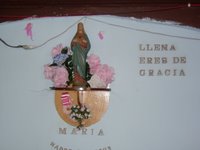 Statue of Mary inside the church.
Statue of Mary inside the church.
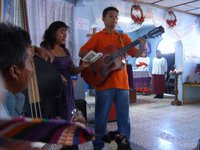 Members of the musical ensemble at Santa Maria Virgen
Members of the musical ensemble at Santa Maria Virgen
Today I had the priviledge of officiating at the Anglican church in El Salvador dedicated to St. Mary, on the fourth Sunday of Advent, with the beautiful Gospel reading from St. Luke on the Annunciation. There were only 50 congregants today--usually Santa María Vírgen has a hundred or more crowded into one of our smallest sanctuaries, actually a house with its interior walls knocked out-- but perhaps the smaller service contributed to the sense of peace and holiness in the celebration. I took the service today for Padre German López, a dynamic veteran priest who is in charge not only of Santa María, one of our fastest-growing churches, but also of three missions in Usulutan along the Lempa River. Padre German and a number of congregants went to Usulutan today (along with my sister Robin and David Starr+) to help in a major celebration of one of these communities-- the anniversary of its founding after the war. But at Santa María we sang (Vince mentions their incredible music ministrybelow--we had a five-piece musical ensemble today, despite the fact that the leaders had gone to Usulutan-- Vince's said after, "This is the second string??"), and prayed, heard scripture (with a dog stretching on the floor during the readings) and meditated on it, and received the Body and Blood of Christ. Santa María is one of the oldest Anglican-Episcopal congregations in the country, and the bishop is looking for someone to help finance the construction of a new church building for them-- a national sancturary dedicated to the Virgen María. Tamales after the service
Tamales after the service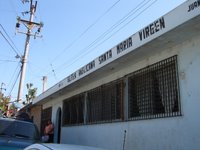 Santa María from the street
Santa María from the street
Saturday, December 10, 2005
Guitar Workshop



Top: Members from various congregations work on chord changes. Middle :Music Director, Mario, from Iglesia Santa Maria Virgen leads
a small group on the basics of guitar.
Bottom: Members from various congregations work on chord changes.
Bottom-Chord changes 1 y 2 y 3 y 4!
On Saturday we held the first all day guitar workshop for the diocese and had a great time. The Bishop has set a goal of having at least two church musicians in every church and mission, and it looks like we are on our way. The students exceeded all expectations, since beginning to learn to play an instrument can be very difficult and frustrating, but all attendees hung tough, and by the end, were strumming the first few bars of Pescador de Hombres. I gave the more advanced players some exercises and techniques to chew on and incorporate into their playing. It's an exciting time, since what music the diocese does have, mainly at Santa Maria Virgen and San Mateo, has an incredible energy to it. Hopefully all I'll be doing is feeding a fire that'll turn into a blaze. A local luthier we discovered down in the depths of El Centro, the chaotic, somewhat dangerous, mercado down in the center of the city, is currently making guitars for all the churches and missions in the diocese which will be paid for by a grant we received from CDSP. Thank you CDSP! We plan on posting pictures of the guitars and luthier's workshop soon. -Vince
Saturday, November 26, 2005
Our Patron Saint Celebration
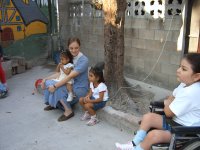


Left:Presidente de la Junta Directiva (Vestry), Victor Ayala, sets off liturgical fireworks during the Dia de San Andres service. As la Reverenda says, "The heck with incense, we've got liturgical explosives!" No one was injured during the service.
Above right: La Reverenda watches the children's games with a few younger congregants.
Bottom right: The procession of the mass with the Bishop, with a little St. Martin's influence at the head of the procession, enters the church.
Thanksgiving in El Salvador
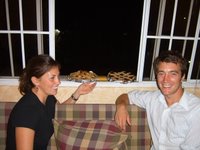
Top: Shannon and Noah offer their made from scratch pies for the meal. Bottom:Amy, Shannon, Noah, Jose, and Padre John
Bottom:Amy, Shannon, Noah, Jose, and Padre John
look forward to dessert.
Thanksgiving was pretty "tranquilo". We had a few friends over and prepared a turkey and could not find any canned cranberries in any of the stores. We had a great time and are thankful for much here especially the diocesan community and hope all our family and friends in the states had a great Thanksgiving.--Vince
Monday, November 14, 2005
Copa del Obispo- Finals



 Top to Bottom: 1.The SAA boys and girls teams 2.SAA boys play Santisima Trinidad. 3. San Jose del Congo play the diocesan Milagros. 4.Boys and Girls teams from SAA 5. Coach and Missioner Caen gives a pep talk to his boys. It worked. They won it all. 6. SAA girls take on Santisima Trinidad.
Top to Bottom: 1.The SAA boys and girls teams 2.SAA boys play Santisima Trinidad. 3. San Jose del Congo play the diocesan Milagros. 4.Boys and Girls teams from SAA 5. Coach and Missioner Caen gives a pep talk to his boys. It worked. They won it all. 6. SAA girls take on Santisima Trinidad. 
Out in the department of Sonsonate at the Community development project of El Maizal the finals of the Copa del Obispo took place. Competition was fierce (one of our girls received a black eye in a scrape-- a little lesson on Christian love may be in order-- though maybe we have a future priest on our hands, you gotta be tough to be a priest here!). In the heat and dust the teams scrapped hard on the field prepared by Inginiero Cabezas and his crew, which included some ERD volunteers. At the end of the day the trophies were bestowed by the Bishop, 1st place in the boys division to San Pablo Letran who defeated San Andres Apostol in the final match in sudden death. The boys from San Andres Apostol told Amy that they were actually happy for the team from San Pablo Letran since it was their first championship. Their is a kindredness between the two teams since the team from San Pablo Letran is from the mission church that was started by San Andres Apostol. She was very proud of their sportsmanship and grace in defeat. In the girls division the girls team from La Divina Providencia from El Maizal won the championship. We had to leave early to get back for the San Andres Apostol Colegio's graduation and learned the scores when Amy called up our feisty backfielder to find out who won. She failed to mention her black eye in the conversation. -Vince
Friday, October 28, 2005
Clergy Retreat at La Palma, Chaletanango
Top- Mural by local artist Juan Carlos who has taken the well-known Llort style in a new direction.
Middle Top-Padres Alex Tobar and John Habeker relax on the patio
Middle- The Very Rev. Dean Bower and Rt. Rev. Martin Barahona hold a discussion after breakfast.
Bottom-Bishop Barahona and Rev. Ramiro Chavez discuss the morning service.
The weather was perfect for the clergy retreat in La Palma, which is a small village up in the northern mountains of El Salvador and is well-known for its artesans. The time of relaxing, spiritual reflection, and learning was much-needed by the clergy who are all in very intense work situations here. It was a time of building and strengthening relationships among the clergy and remembering to slow down and take care of one's self in the midst of all that is going in the neighborhoods and parishes. The retreat was led by the Very Reverend Richard Bower and focused on fostering the spiritual growth of the clergy. I was lucky enough to be asked to handle the music for the retreat and was graciously included in all the discussions and teaching, which was very beneficial for fostering my own spiritual growth. As things pickup with the music and get busier, I'll need to be even more aware to focus on setting aside time to commune with God and develop my interior life to better handle what occurs in the world around me. To be able to get to know the clergy from around the Diocese and to hear their stories was amazing. Their personal stroies about their spiritual journies in El Salvador are powerful and I hope that one day they will share them with the wider church, especially the church in the U.S. The Episcopal Church in the United States has much to learn from the Anglican/Episcopal Church of El Salvador- much to learn about relationship and mission and how to do God's work in spite of limited resources, in spite of violence and poverty. "God is not in the church buildings," the Bishop told Amy and I once, "God is in the world--in the streets." This is where the Anglican Church of El Salvador is thriving out in the campo, in the streets, where God is calling his people to work. These were a few meditations I mulled over at the retreat. It was challenging and edifying.
Monday, October 24, 2005
Jamming In San Salvador
Thursday, October 06, 2005
Messages from the children of San Andrés Apostol Episcopal Church and School to Gulf Coast Hurricane Victims
 The children's messages:
The children's messages:
“We love you with all our heart. We love you a lot, with this hurricane we hope you are well. The day it arrived we were praying.”
“Don’t be sad, my brother, God loves you. This flower is about to be born, like you in the heart of God. Be happy like this bear and this squirrel.”
“I hope that you are fine after the Hurricane Rita and that you can return to your homes.”
“Dear people I want to tell you that I hope you are very well in your houses. Be careful with the hurricanes. I would like to meet you one day.”
“For those who suffered the Hurricane Katrina, I wish you luck and that your family members are well.”
“We love you a lot and are sending you these cards to tell you we love you. We know that the hurricane left you without a house.”
“I am very sorry, don’t feel alone. May God bless you a lot. Don’t be sad my brothers and sisters. We know what has happened to you.”
“El Salvador is with you. Friend, I am sorry about what has happened, but don’t loose heart, keep moving ahead. May God help you to move ahead and be strong.”
“I want to tell you that we are praying a lot for you. I am very sorry for what happened.”
“For the United States. Lord, I ask you to bless the United States.”
“I desire for those who suffered Hurricane Katrina that they have faith and that nothing else happens to them.”
“Don’t be sad, all this will pass, I’m telling you as a friend. Everything that you lost God will give back to you, and I believe God will give you more than you lost. God bless you.”
“God is the light of the world. God bless you. In our country we hope that you will be protected by our almighty God. After this tragedy, we hope that you get better with blessings from the almighty.”
Monday, October 03, 2005
Independence Month Activities at Colegio Episcopal San Andrés Apostol
September was a full month at Colegio Episcopal San Andrés Apostol, the pre-k through sixth grade elementary school I became director of when I assumed responsibilities as clergy-in-charge of the parish. September 15 is Salvadoran Independence Day, but the festivities really last for the entire month of September. A Salvadoran friend told us that it was only recently, as a part of the peace accords that ended the Civil War in 1992, that the schools started teaching 2oth Century history- up until then, history lessons stopped with Central America's independence from Spain in 1821. According to our friend, that was why the Month of Independence traditionally got to be such a big celebration.
At San Andrés, the Independence Month festivities included three parades around the neighborhood featuring the school drum and trumpet band (recently funded by a donation from our sister parish in Massachusetts) and baton team, numerous "actos" featuring the singing and dancing talents of the students, a contest/fundraiser to see who would become the "Queen of Independence," a drawing contest on the subject of peace, a sports day, and a science fair. Click on the pictures below if you want to see them in greater detail.
 Amy poses with the four-year-old "Queen of Independence" of Colegio San Andrés Apostol.
Amy poses with the four-year-old "Queen of Independence" of Colegio San Andrés Apostol.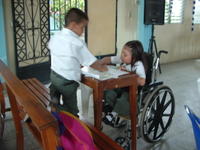 Two students work on their contest drawings on the theme of peace.
Two students work on their contest drawings on the theme of peace. Students and teachers recite the pledge of allegiance in the church, decorated for Independence Month.
Students and teachers recite the pledge of allegiance in the church, decorated for Independence Month. Members of the band march through the neighborhood on the parade route.
Members of the band march through the neighborhood on the parade route. Two candidates for ¨Queen¨ share a vehicle in the candidates´¨coming out¨parade. Picture a line of these!
Two candidates for ¨Queen¨ share a vehicle in the candidates´¨coming out¨parade. Picture a line of these! The baton team in action.
The baton team in action.The drum and trupet band, or ¨Banda Paz¨ stands at attention before the parade begins.
I just have to tell you how much I love these kids already! I feel like I have 82 children. Besides being extra-adorable (I really think they got an extra dose of cuteness- maybe it's the Spanish!) they just have such pure hearts. The fourth-grade girl who was the incumbent Queen looked like a super-model riding on the taxi at the very front of the first parade, and after she passed on her crown, she was just as happy marching with the other children in her school uniform at the back of the last parade. They come from low-income working families and do not have much (monthly tuition is $10, going up to $12 next year, and we could use more money for scholarships), but they are so ready to give--they have such open hearts. I really want to give them the best education possible, and we've got a start-- small class sizes (10-20 versus 50-60 in the public schools), enrichment activities like the ones you see above, and for next year greatly improved computer and English classes due to the generosity of friends, with the possibly of an environmental stewardship class as well. I hope that some of you get a chance to meet "my kids" in person! I'm sure they'll steal your heart as well. -Amy
La Copa del Obispo- preliminaries
Wednesday, September 28, 2005
Mucho Trabajo-Sunday Sept. 21
Left and below: Members of San Andres Apostol
Above: Visiting after the morning service
Sunday was a bit of a long day. It started at 8:00am and ended around 6:00pm. We sleepily started with the morning service at San Andres Apostol, the night before was the Vigilio de Avivimiento that lasted from 7-midnight which meant we got home around 1:00am. It doesn't have to be Easter around here to have a vigil, in fact there's another one this Saturday for the women of the diocese. After the morning service, we headed out to the outskirts of a pueblo called El Congo to the Iglesia Anglicana San Jose del Congo. Surrounding the church is a community "Via Anglicana" built with the help of Episcopal Relief and Development. Via Anglicana is one of four such developments in the country and is made up of families who lost their homes due to the major earthquake in 2001. We were in Via Anglicana to attend a gathering of youth from another church in the diocese, Santisima Trinidad from San Martin, an outlying town that is apart of greater San Salvador. Amy was asked to speak to the youth about women entering the priesthood and other ministries, which seemed apt since most of the youth group was made up of girls. The youth around San Salvador and the outlying cities and pueblos have enormous issues to deal with. The pressure from the gangs to join them is intense(every member of the youth group at Amy's church has been approached and pressured by the gangs). Teen pregnancy is very high, an occurence that has stopped some from pursuing a call to the minstry, with girls as young as twelve years old sometimes becoming pregnant in the more rural areas. Poverty, the lack of adequate employment, all of these are issues that the youth here are immersed in, among many others. In talking with them you realize how important the role of family and the church is in their lives- an anchor among situations that have swept others away. These kids have incredible heart and strength, and if they survive, can lead the church in a powerful direction. I pray that God would protect them and that they would embrace the call, which was apparent at the retreat, that God has for them.
-Vince
P.S. The title of this posting is a double-entendre-- there certainly is plenty of work here, and Vince told the kids at the youth retreat that being my husband was "mucho trabajo"! -Amy
Youth Retreat at El Congo
The Rev. John Habeker and the Rev. Cesar
Hernandez preside over the evening service
at San Jose del Congo
Above: Rev. Amy Zuniga, Rev. Cesar Hernandez,
and los jovenes from Santisima Trinidad, before
a discussion on calls to ministry, in particular
women in the priesthood.
Above: Youth fromSantisima Trinidad, San Martin at the retreat.
The afternoon coffee club of El Congo stops
for a bit of Java, well, a whole lot of Java and
philosophizing. These hearty young men
after a long and grueling day in the throes
of their recent green coffee bean fight, like
to enjoy a good cup of coffee like any other
six year old. They start 'em on a good cup of Joe
young here in El Salvador. Here as they relax
after discussing the correct way to prepare a good
cup of coffee,"Is it five or ten spoons of sugar per cup?"
they engage in applying the universal sign
of annoyance and which has ruined millions of
pictures the world over, "bunny ears".











